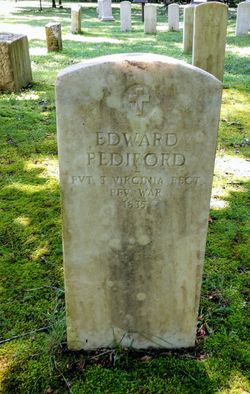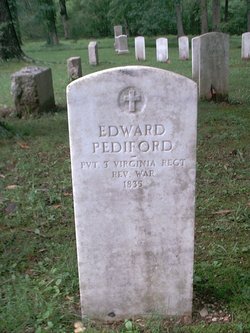Edward PEDIGO/PEDIFORD
SAR Patriot #:
P-267850
The following information was assembled from numerous sources and cannot be used directly as proof of Qualifying Service or Lineage.
It is considered a research aid and is intended to assist in locating sources that can be used as proof.
State of Service: VA
Qualifying Service: Private / Patriotic Service
DAR #: A087986
Birth: 24 Dec 1732 / / France
Death: 26 Apr 1834 / Barren / KY
Qualifying Service Description:
- Furnished Supplies
- Pvt - Capts, Young, Fleming, Col Russell, Heth, 3rd, 5th, 7th, 11th Regts, VA
Additional References:
- VA in the Revolution, pg 613
- Brumbaugh: Rev War Records, Volume 1, pg 486
- NSDAR cites
- NARA M881, Compiled Military Service Records, Roll #995
- Aberbrombie and Slatten, VA Revolutionary 'Publick' Claims, Vol 2, pg 517
Spouse: Mary Hannah Elkin
Children: Joseph; Levi; Henry; Abel; Elizabeth; Bathsheba; Elijah; Lucy; John;
Members Who Share This Ancestor
| Date Approved | Society | ACN | SAR Member Info | Lineage via Child | View Application Detail | |
|---|---|---|---|---|---|---|
| 1992-01-08 | VA | 214166 | Jack Bertram Coulter (138061) | Lucy | ||
| 2006-09-14 | KY | 26292 | Don Carlos Graeter (167706) | Joseph | ||
| 2006-09-14 | KY | 26293 | Drew Joseph Graeter (167707) | Joseph | ||
| 2006-09-14 | KY | 26294 | Spencer Harris Graeter (167708) | Joseph | ||
| 2009-12-22 | KY | 37314 | Jon Ellis Huffman (172987) | Joseph | ||
| 2010-09-15 | NM | 40305 | Samuel David Bradley (177962) | Joseph | ||
| 2013-06-19 | KY | 53579 | Jon Darren Huffman (187635) | Joseph | ||
| 2013-06-19 | KY | 53580 | Jeremy Matthew Huffman (187636) | Joseph | ||
| 2013-06-19 | KY | 53581 | Quinten Edward Huffman (187637) | Joseph | ||
| 2013-10-03 | VA | 55171 | Scott Daniel Aiken USMC (152900) | Henry | ||
| 2014-02-25 | IN | 57166 | Stanley Eugene Isaac (186161) | Levi | ||
| 2014-03-06 | SC | 57194 | Douglas Arnold Puckett (187272) | Bathsheba | ||
| 2016-08-09 | VA | 70634 | Lester Daryle Hurt (199541) | Joseph | ||
| 2018-08-24 | WA | 81978 | Paul Richard Clifton (196524) | Bathsheba | ||
| 2018-12-21 | VA | 84250 | Christopher Blaine Hurt (209972) | Joseph | ||
| 2018-12-21 | VA | 84251 | Timothy Blaine Hurt (209973) | Joseph | ||
| 2021-01-29 | OH | 95493 | Mark Anthony Hensler (218092) | Joseph | ||
| 2021-01-29 | OH | 95494 | Mark Anthony Hensler Jr. (218093) | Joseph | ||
| 2022-07-01 | TN | 102484 | Jeffery Paul Pedigo (222993) | Joseph | ||
| 2022-09-02 | IL | 103470 | William Wesley Clifton (223669) | Bathsheba | ||
| 2022-09-02 | IL | 103471 | Robert Yountz Clifton (223670) | Bathsheba |
Location:
Tompkinsville / Monroe / KY / USA
Find A Grave Cemetery #:
Marker Type:
Headstone
SAR Grave Dedication Date:
Comments:
- Patriot contemporary stone, upright, legible, refurbished
- Image 1, provided with permisson from Jane Grubbs, Find-a-Grave member #49245189
- Image 2, provided with permission from Mark Bennett, Find-a-Grave member #46629798
Directions to Cemetery / Gravesite:
From highway 163 in Tompkinsville, turn south on highway 1446 (Old Mulkey Rd) and proceed about 1.8 miles. Old Mulkey Park is on the right. The cemetery is located to the right of the Old Church
Additional Information:
DAR NOTE: (there are potential issues) regarding this man's lineage HANNAH ELKIN, NOT MARY ELKIN, WAS THE WIFE OF THE PATRIOT & MOTHER OF HIS CHILDREN. 3/2021

